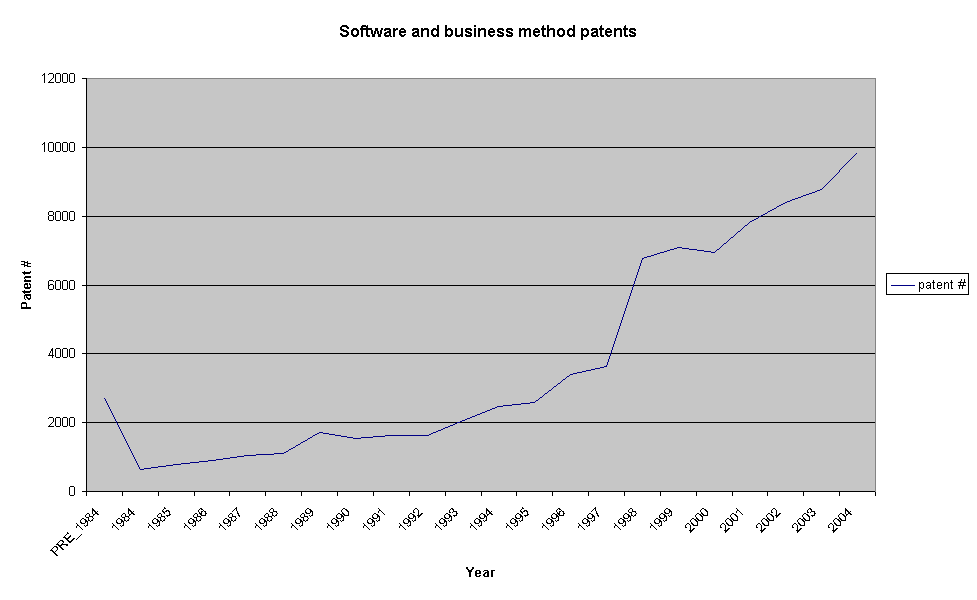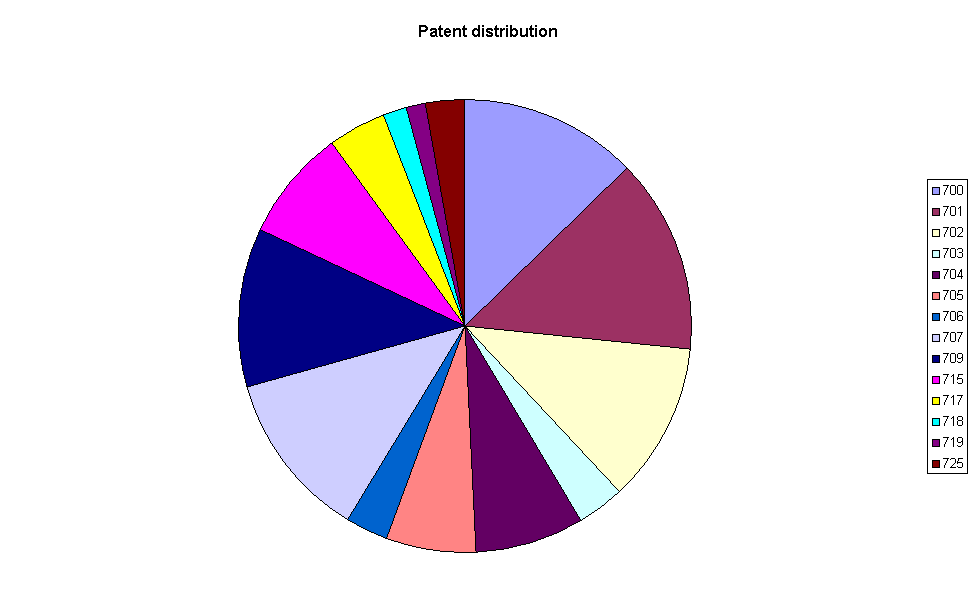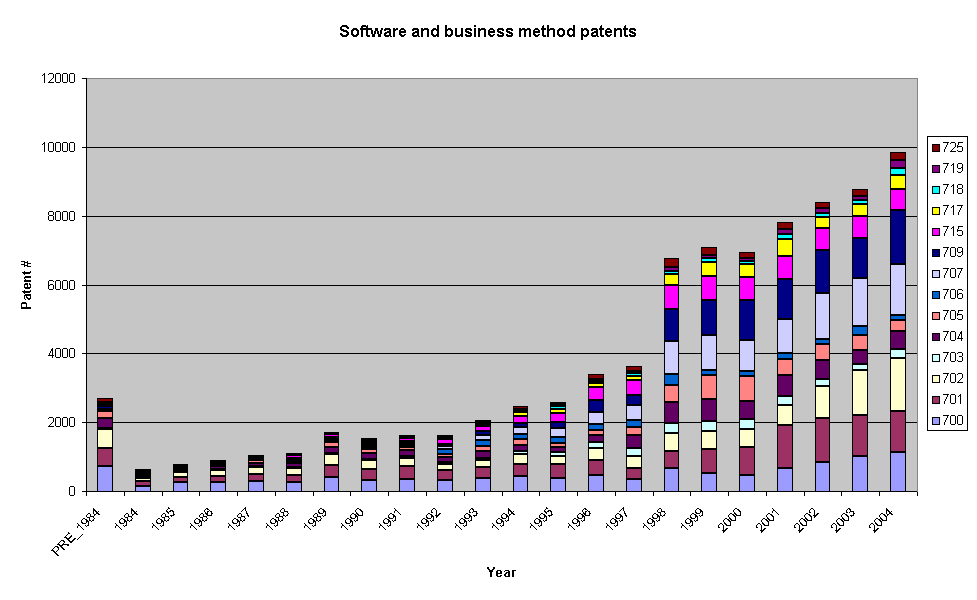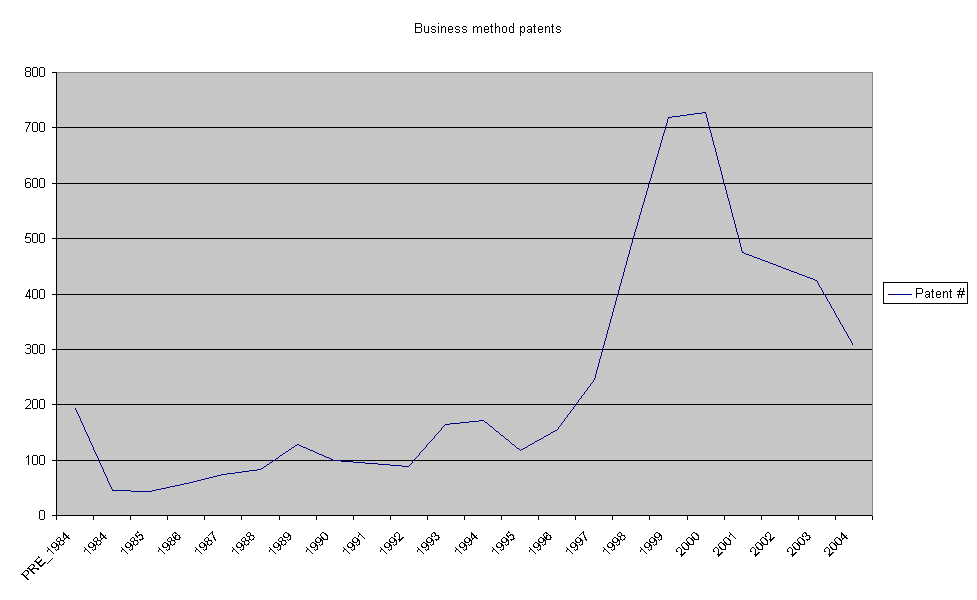 |
PageBox |
| Support | Map |
|
|
|
|
|
|
|
|
Evolution of the number of software and business method patents granted by the USPTO
In this page we use USPTO data to analyze the evolution of the number of software and business method patents granted since 1977. We find that the number of software patents granted is still increasing and that the number of modern business method patents granted decreases since 2001. Because we did not find corresponding application filing stats we could not check if the fall of the number of modern business method patents granted was only the consequence of a higher rejection rate. Business method patents may be not anymore an adequate tool for defensive purpose given
the certain burden of writing patent applications and prosecuting their examination;
the certain disclosure of the matter of the applications;
the uncertainty of the examination outcome.
We define a software invention as an invention made by people with a computer science background that had to solve a problem formulated in computer science terms.
We define a modern business method invention as a software invention made by people that had to solve a non-technical problem.
A patent being a property right sought by people to make or secure profits, non-technical problems logically relate to money and property and thus the 705 class entitled “Data Processing: Financial, Business Practice, Management, or Cost/Price Determination” contains most modern business method patents. Therefore the study of the applications classified in the 705 class give a good idea of the numbers of modern business method applications filed and granted.
There is no indisputable way to measure the number of software inventions.
The modern way to solve problems is to design sensors, actuators, computers and programs. Sensors analyze the environment and convert their measurements into numbers that can be processed by computers. Actuators act upon the environment according to numbers provided by computers. Programs use numbers provided by sensors to calculate numbers used by actuators. This method is cheaper because computers, sensors and actuators are as unspecialized as possible, allows fast progress because it allows quickly integrating improved computers, sensors or actuators and provides flexibility. To address a new need this is enough to select appropriate sensors and actuators and to write or modify a program. There are relatively few mass-produced actuators, sensors and computers and much more programs.
Actuators, sensors and computers solve technical problems with technical means just because today they necessarily deal with electric current carrying numbers. Regardless of the nature of the problem programs get numbers and produce numbers using models and algorithms. An illustration of this fact is provided by online resumes that show how easily programmers move from one domain to another domain. This also explains why this is so difficult to draw a patentability borderline.
Inventions combining actuators, sensors, computers and programs solve technical problems but today their novel and inventive part is usually concentrated in the program. They primarily differ from business method patents in that they claim combinations of software and hardware means. According to our definition such inventions are software invention though they sometimes solve problems in domains in which past inventions used mechanical and analogical means.
We chose to consider inventions that were originally classified in classes 700 to 707, in classes 709 and 715, in classes 717-719 and in class 725. Some inventions classified in these classes are not software inventions and some inventions in other classes are software inventions.
The class 700 is entitled “Data Processing: Generic Control Systems or Specific Applications.” The USPTO defines the class 700 in the following way:
“This class is structured into two main divisions: (A) Generic Control System, Apparatus or Process and (B) Specific Application, Apparatus or Process. [...]
(A) This is the generic class for the combination of a data processing or calculating computer apparatus (or corresponding methods for performing data processing or calculating operations) AND a device or apparatus controlled thereby, the entirety hereinafter referred to as a ‘control system’.
(B) This is also the generic class for data processing or calculating computer apparatus (or corresponding methods for performing data processing or calculating operations) wherein the data processing or calculating computer apparatus is designed for or utilized in a particular art device, system, process, or environment, or is utilized for the solution of a particular problem in a field other than mathematics (arithmetic processing per se is classified elsewhere).”
The class 701 is entitled “Data Processing: Vehicles, Navigation, and Relative Location.” This is the class in which applications dealing with geo-location are defined. The USPTO defines the class 701 in the following way:
“A. This class is for electrical apparatus and corresponding methods for performing data processing operations in which there is a significant change in the data or for performing calculation operations wherein the electrical data processing system or calculating computer functions to indicate a condition of a vehicle, to regulate the movement of a vehicle, to monitor the operation of a vehicle, or to solve a diagnostic problem with the vehicle.
B. This class also provides electrical apparatus and corresponding methods wherein the electrical data processing system or calculating computer function to determine the course, position, or distance traveled.
C. This class further provides electrical apparatus and corresponding methods wherein the electrical data processing system or calculating computer functions to determine the relative location of an object (e.g., person or vehicle) and may include communication of the determined relative location to a remote location.”
The class 702 is entitled “Data Processing: Measuring, Calibrating, or Testing.” The USPTO defines the class 702 in the following way:
“This class provides for apparatus and corresponding methods wherein the data processing system or calculating computer is designed for or utilized in an environment relating to a specific or generic measurement system, a calibration or correction system, or a testing system.”
The class 703 is entitled “Data Processing: Structural Design, Modeling, Simulation, and Emulation.” The USPTO defines the class 703 in the following way:
“A. Processes or apparatus for sketching or outlining of layout of a physical object or part.
B. Processes or apparatus for representing a physical process or system by mathematical expression.
C. Processes or apparatus for modeling a physical system which includes devices for performing arithmetic and some limited logic operation upon an electrical signal, such as current or voltage, which is a continuously varying representation of physical quantity.
D. Processes or apparatus for modeling to reproduce a non-electrical device or system to predict its performance or to obtain a desired performance.
E. Processes or apparatus for modeling and reproducing an electronic device or electrical system to predict its performance or to obtain a desired performance.
F. Processes or apparatus that allows the data processing system to interpret and execute programs written for another kind of data processing system.”
The class 704 is entitled “Data Processing: Speech Signal Processing, Linguistics, Language Translation, and Audio Compression/Decompression.” The USPTO defines the class 704 in the following way:
“This is the generic class for apparatus and corresponding methods for constructing, analyzing, and modifying units of human language by data processing, in which there is a significant change in the data.
This class also provides for systems or methods that process speech signals for storage, transmission, recognition, or synthesis of speech.
This class also provides for systems or methods for bandwidth compression or expansion of an audio signal, or for time compression or expansion of an audio signal.”
The class 705 is entitled “Data Processing: Financial, Business Practice, Management, or Cost/Price Determination.” This is the modern business method class. The USPTO defines the class 705 in the following way:
“This is the generic class for apparatus and corresponding methods for performing data processing operations, in which there is a significant change in the data or for performing calculation operations wherein the apparatus or method is uniquely designed for or utilized in the practice, administration, or management of an enterprise, or in the processing of financial data. This class also provides for apparatus and corresponding methods for performing data processing or calculating operations in which a charge for goods or services is determined.”
The class 706 is entitled “Data Processing: Artificial Intelligence.” The USPTO defines the class 706 in the following way:
“This is a generic class for artificial intelligence type computers and digital data processing systems and corresponding data processing methods and products for emulation of intelligence (i.e., knowledge based systems, reasoning systems, and knowledge acquisition systems); and including systems for reasoning with uncertainty (e.g., fuzzy logic systems), adaptive systems, machine learning systems, and artificial neural networks.”
The class 707 is entitled “Data Processing: Database and File Management or Data Structures.” The USPTO defines the class 707 in the following way:
“This is the generic class for data processing apparatus and corresponding methods for the retrieval of data stored in a database or as computer files.
This class provides for data processing means or steps for organizing and inter-relating data or files (e.g., relational, network, hierarchical, and entity-relationship models).
This class also provides for data processing means or steps for generic data, file and directory upkeeping, file naming, and file and database maintenance including integrity consideration, recovery, and versioning.”
The class 709 is entitled “Electrical Computers and Digital Processing Systems: Multicomputer Data Transferring or Plural Processor Synchronization.” This is typically the class of patents related to transaction monitors, web servers, browsers and applets. The USPTO defines the class 709 in the following way:
“This class provides for an electrical computer or digital data processing system or corresponding data processing method including apparatus or steps for transferring data or instruction information between a plurality of computers wherein the computers employ the data or instructions before or after transferring and the employing affects said transfer of data or instruction information.”
The class 715 is entitled “Data Processing: Presentation Processing of Document, Operator Interface Processing, and Screen Saver Display Processing.” The USPTO defines the class 715 in the following way:
“This class provides for data processing means or steps wherein a) human perceptible elements of electronic information (i.e., text or graphics) are gathered, associated, created, formatted, edited, prepared, or otherwise processed in forming a unified collection of such information storable as a distinct entity, b) a user s interaction with a computer system is used to control the presentation of display data; such interaction is interpreted and used by a data processor or computer architecture wherein system level elements of computation or data processing techniques are used prior to use with or in a specific display system, or c) a small program takes over a display screen if there are no keystrokes or mouse movements for a specified duration.”
The class 717 is entitled “Data Processing: Software Development, Installation, and Management.” The USPTO defines the class 717 in the following way:
“This class provides for software program development tool and techniques including processes and apparatus for controlling data processing operations pertaining to the development, maintenance, and installation of software programs.”
The class 718 is entitled “Electrical Computers and Digital Processing Systems: Virtual Machine Task or Process Management or Task Management/Control.” The USPTO defines the class 718 in the following way:
“This class provides for an electrical computer or digital data processing system or corresponding data processing method including apparatus or steps for administrating over processor or job execution in a digital data processing system whether in a virtual machine or otherwise.”
The class 719 is entitled “Electrical Computers and Digital Processing Systems: Inter-program Communication or Inter-process Communication (IPC).” The USPTO defines the class 719 in the following way:
“This class provides for an electrical computer or digital data processing system or corresponding data processing method including apparatus or steps for exchanging data or messages between two executing programs or processes, independent of the hardware used in the communication.”
The class 725 is entitled “Interactive Video Distribution Systems.” The USPTO defines the class 725 in the following way:
“This class contains interactive video distribution processes, systems, and elements thereof, which are characterized by point-to-multipoint system configurations, and which are used for the unidirectional distribution or delivery of motion video data resulting from interactions between systems operators (access or service providers) or users (subscribers) and systems elements.”
We used statistics from the USPTO found at http://www.uspto.gov/web/offices/ac/ido/oeip/taf/cbcby.htm#PartA1.
The graph below shows the evolution in number of granted patents in classes 700 to 707, in classes 709 and 715, in classes 717-719 and in class 725.

The number of software patents granted grows. The fastest growth occurs in 1998. The number of software patents granted marginally decreases in 2000 and increases again later at a rate of 4-12%. A patent is granted two years and more after the filing date and usually follows from an effort for reducing the invention to practice of one year. So even if the curve matches the eCommerce boom and collapse no direct link should be drawn between the number of software patents granted and the eCommerce fate. There was probably a combination of factors.
following the birth of the Web in 1994 companies and entrepreneurs undertook research efforts,
companies realized that the USPTO allowed patenting software inventions, and even business method (the State Street decision was made in 1998.)
A big increase of the number of application filings probably implies a technological boom two years later. However we think that the 2000 decrease was due to a higher rejection rate rather than to a decrease of the number of application filings.

Software patents were granted primarily in five classes:
701 (“Data Processing: Vehicles, Navigation, and Relative Location”): 11,453 patents,
700 (“Processing: Generic Control Systems or Specific Applications”): 10,716 patents,
707 (“Data Processing: Database and File Management or Data Structures”): 9,966 patents,
709 (“Electrical Computers and Digital Processing Systems: Multicomputer Data Transferring or Plural Processor Synchronization”): 9,665 patents,
702 (“Data Processing: Measuring, Calibrating, or Testing”): 9,662 patents.
Only 5350 patents were granted for modern business method patents.
The total number of granted patents in classes 700 to 707, in classes 709 and 715, in classes 717-719 and in class 725 is 83,476.

The proportion of modern business method patents decreases since 2002.
The proportion of 702, 707 and 709 patents increases. In 2004 1494 707 patents, 1516 702 patents and 1569 709 patents were granted when only 307 modern business method patents were granted. The total number of granted patents in classes 700 to 707, in classes 709 and 715, in classes 717-719 and in class 725 was 9,841 in 2004.

Since 2001 the number of granted business method inventions decreases. The 2002 collapse is the consequence of a higher rejection rate. The 2004 reduction may follow from tighter patentability rules and from a reduction or diminishing growth of the number of business method applications.
Patentability of business method invention is still a debated topic. The USPTO seems to have chosen a middle term, consisting in not forbidding modern business methods applications but in making difficult to get business method patents. Today companies have less chance for getting a patent for a business method application than for another type of application, and even for another type of software application.
A modern business method invention that uses computational means for the practice, administration, or management of an enterprise, for the processing of financial data or for performing data processing in which a charge for goods or services is determined requires the same ingenuity and skills as a regular software invention and even as any other invention. This is something under the sun made by man that is not an abstract idea. But business method applications do not claim combinations of software and hardware means. This complicates the task of the patent office in two ways:
How to reliably identify the prior art for such applications?
How to properly assess the scope of such applications? Patents aim to reward inventors, not to impede business development as it can be the case if granted scopes are too wide. This is already a hard-enough task for other software applications as illustrated by the Eolas patent (class 709).
Patents Presentation Search Issues Strategies Business Methods Patentability Analysis MercExchange eBay Trial Reexamination Business view Granted patents Examination USPTO EPO PanIP Eolas 1-click family 1-click analysis 1-click prior art Trademark Copyright
Contact:support@pagebox.net
©2001-2005 Alexis Grandemange
Last modified